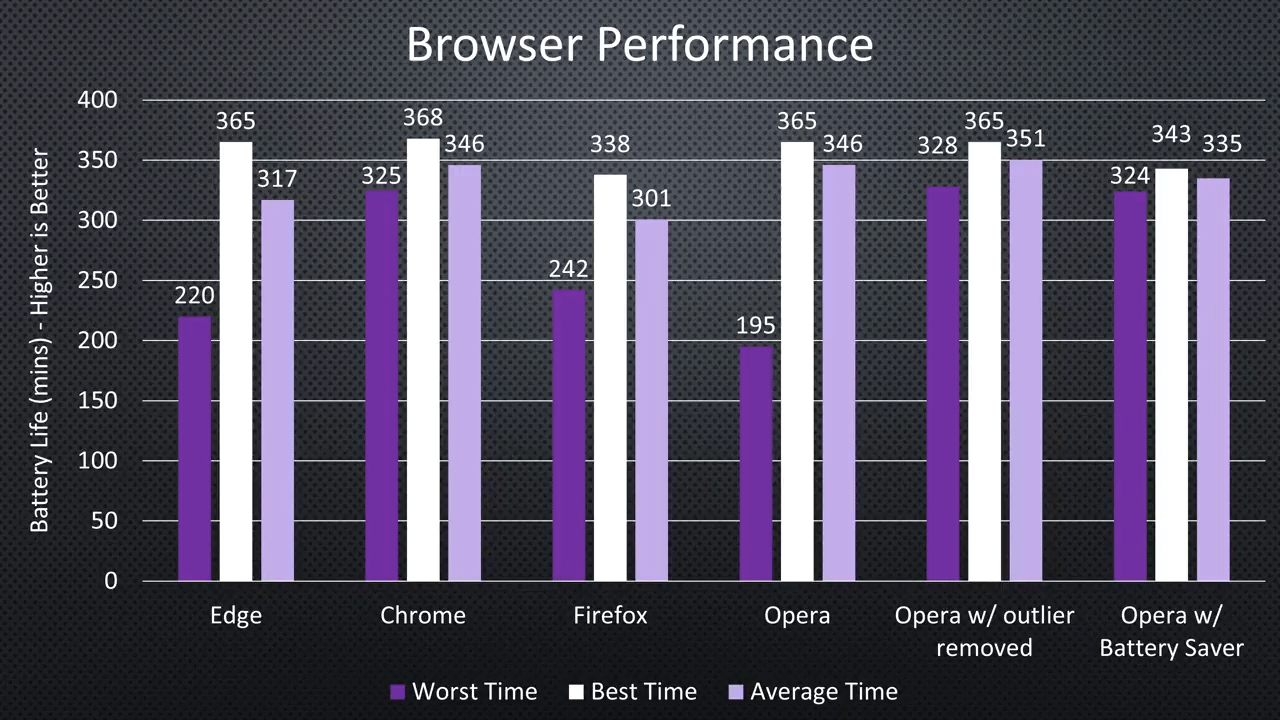In the independent test, Chrome and Opera were the most energy efficient.

A year ago, Microsoft boasted that the most energy-efficient browser under Windows 10 is Microsoft Edge. The company has developed its own test, which includes opening sites, scrolling articles, watching videos, opening new tabs for each task. Then, a test with a list of standard tasks was launched in every browser under Windows 10, opening a list of popular sites: Facebook, Google, YouTube, Amazon, Wikipedia, etc. It turned out that Edge power consumption in milliwatts is 36-53% less in comparison with Chrome, Opera (in power saving mode) and Firefox. This gave Microsoft a reason to show such "tips" to Chrome users, as in the screenshot above. Like, Chrome quickly empties your battery, better go to Edge to work on a laptop longer.
Last year, in response to bias charges, Microsoft published a testing methodology (all scripts) on GitHub so that everyone could repeat the test and get the same results.
The developers of other browsers accepted the challenge - and over the past year they made the necessary optimizations in the code, especially in terms of freezing processes in inactive tabs. The results were not long in coming. Now an independent test showed that the most energy-efficient browser on Windows 10 is no longer Edge, but Chrome and Opera.
')
Independent testing was conducted by well-known techlobloger Linus Sebastian (leading channel LinusTechTips). He compared Edge, Chrome, Firefox and Opera to each other.
The Linus team took four completely new identical Dell Inspiron laptops with Windows 10, removed everything superfluous from them, set the display brightness to 50%, speaker volume to 15% - and launched a test of its own design that simulates real work on the Internet.

Each of the laptops had its own browser - Edge, Chrome, Firefox and Opera, respectively. Then the laptops swapped and tested the next browser. As a result, each laptop ran the test with each of the four browsers. Power consumption tested before and after installing the latest Creators Update update. The results are shown in the diagram - for each of the four laptops indicated the time in minutes for each of the browsers. The higher the bar, the better the result.

The results are interesting for several reasons. First, they demonstrate a strange inconsistency. For example, on the first and second laptops Opera worked the longest, and on the third laptop Chrome took the lead. The strangest thing is that all other browsers on the third laptop showed their worst results, while Chrome showed its best result here.
In terms of averages, Chrome ranked first, Opera second, and Edge only third, 40 minutes behind. If we discard the strange results of the third laptop, then Opera would take the lead. Moreover, in the alternative interpretation of the results in terms of the average, Opera is the leader in terms of average running time (Linus did not explain in his video podcast plainly how the results of the first table differ from the second).

Even installing Creators Update did not help Edge browser overtake Chrome and Opera.

A test was also conducted to view Vimeo videos in the browser. This test was conducted using the Microsoft methodology. And here Edge failed to confirm last year’s leadership. Chrome and Firefox divided the first place among themselves, Edge took the second place, Opera - the third.

These tests show that power consumption is a very subjective thing. Even on two identical computers it may differ for different browsers. That is, on one laptop, the Edge battery will be the most powerful of all, and on the other, Firefox, these are quite individual results. Probably, some tiny differences in the equipment affect the power consumption. Maybe somewhere the WiFi transmitter works a little better and consumes less power when the browser is running. It may even affect the location of the laptop on the desktop.
A team of testers immediately after receiving laptops drove them to the PCMark 8 Home benchmark twice, and even he showed different results on exactly the same laptops.

It seems that in each case it is necessary to study this question individually. In addition to the browser itself, various system settings are important, including whether support for hardware video decoding is included. For example, one video player can run on battery twice as long as another. It is said that under Windows 10 the built-in video player from Microsoft works much longer than VLC or MPC-HC, and this fact cannot be changed with any settings.
Source: https://habr.com/ru/post/373583/
All Articles